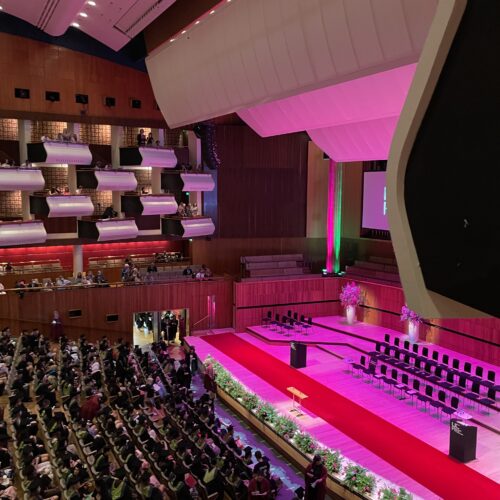
Night will fall – Part 2.
The Director’s Version.
Probably the most important quality a film-maker needs is curiosity. Couple that with serendipity and remarkable things can happen. A researcher at the Imperial War Museum (IWM) whilst reading the then recently published biography of Sydney Bernstein by Caroline Moorhead, (Jonathan Cape UK 1984), learned about the unfinished film of the liberation of the concentration camps at the end of WW11 that Bernstein had started.
The story of the archive lying unnoticed in the IWM archive provoked considerable global media interest and in in the same year the Berlinale Film Festival agreed to show the existing five reels of archive. However, it needed finishing and the archivists at the IWM set to work. PBS, the public broadcast service in the USA agreed to help with the funding including the use of an American commentary. The film was subsequently screened in the US and Steve Morrison, then Head of Granada Television, made a version with additional interviews, some of which André Singer used in his re-telling of the story some twenty five years later.
After the death of Sydney Bernstein in 1993, (who was made a baron in 1963), his lawyer son David set up a foundation in his father’s name. He wanted the IWM to restore the film in his father’s memory and this was completed in 2013. It was subsequently premiered at the Berlinale Film Festival titled Memory of the Camps in 2014 although it had limited distribution internationally. However, when the film’s restoration had been completed André Singer was asked if he would be interested in producing a documentary about the making of the film. Singer was keen to find a director who had a connection to Bernstein. Michael Apted and Paul Greengrass were both ex-Granada Television directors but both felt unable to be involved. Stephen Freers was also approached to direct the film but declined, agreeing however to come into the production as an Executive Producer with Singer, who took on the job of director.

Singer was keen to find stories today that resonated with the events of the time. He was able to mine the material Morrison had filmed for the Granada version twenty five years earlier for contributors. Through skilled and forensic research his team was able to find in America one of the survivors filmed with a soldier in the first shots of the original film. In this way Singer was able to tell the same story from three different perspectives. He also was determined to be relatively conventional in telling the story. So he found three historians who provided their own perspectives on the narrative and filmed them in three different camps.
However, as Singer started to assemble the material he realised that the narrative elements and interviews were far more powerful without having his trio of historians and contemporary filming in the camps. He talks of a eureka moment in the cutting room when it was agreed to junk the material – a very expensive editorial decision. Singer decided only to use archive when it was relevant to what was being talked about by the contributors. He was able to select archive that was specific to what was being said. In his 75-minute film only 12.5 minutes was archive from the concentration camps.
The production was complex to finance requiring 14 different funders – a political and logistical nightmare at times for the film’s producer, Richard Melman. However, the production was able to function as a closed unit – thanks to the fact that there were so many funders involved and none of them had a controlling financial stake – which enabled Singer to work without external editorial involvement. He tells the story of the launch of the film with much fanfare by one of the funders HBO, who had engaged Brett Ratner, a Hollywood director who at the time Singer was making Night Will Fall was filming Hercules (USA 2014), as Executive Producer.
The launch party was held at the Jewish Museum in New York were Ratner introduced the film making no reference to Singer, the director – proof if ever it was needed of the power and sizes of egos within the film industry. Channel Four were the British partner and weren’t involved in the feature-length version which HBO screened. However, they insisted on their version having a different introduction. For the student of film culture, noting the differences in versions and who is used for narration can be insightful. However, the biggest editorial issues were between Singer and the IWM who had a different view about what the film should have been about. Originally, as production partners the IWM archive was to be supplied at no cost, but due to this editorial parting of the ways the production ended up having to pay the IWM for its use – another big budget shock.
Exploitation of the finished film in order to recoup the cost of investment was yet another issue. Singer’s production company Spring Films wanted to market a DVD with both his film and the 2013 IWM version but the IWM would not agree to this with the result being that if you want to see both films you have to pay twice. One of the UK’s biggest educational charities, the Holocaust Educational Trust, declined to put together an educational package for schools because they have a policy of not showing images of the dead to children, despite seeing the film at an intergovernmental conference of Holocaust related institutions in Manchester where the film received critical acclaim. Today Spring Films continues to explore ways to bring the film into schools.
André Singer always expected the film to be well received, but as he says, ‘It was a slow burn.’ It failed to be nominated for either a BAFTA or an Oscar, but received the prestigious Peabody prize recently and is nominated for five Emmy Awards, (Long Form Documentary, Writing, Music, Editing and Research) – the first time any documentary has ever been nominated for more than one award. The film has been screened and broadcast around the world to considerable critical acclaim.
In conclusion, it is worth reflecting on the use of archive of people who are still living and those who have died. Singer’s film treats the area of memory at the point where we at the very end of living memory where we can see archive in the context of living memory. Already three people interviewed in Night Will Fall have died since the film’s release. Adventures in the Lives of Others: Ethical Dilemmas in Factual Filmmaking edited by James Quinn (I.B Tauris UK 2015) explores the issues of ethics, problem-solving and decision-making with interviews with many of the world’s most influential documentary producers and directors. An accessible and compelling read.
Both films, Night Will Fall and Memory of the Camps are available from the BFI.






Thank you Adam for this fascinating piece detailing how these films came to be made.
The portrayal or otherwise of atrocity is a challenging area for the arts more generally than just film. Claude Lanzman famously did not use any archive footage in Shoah and Jean Luc Godard equally notoriously insulted Steven Speilberg for recreating Auschwitz for the sake of storytelling. His views have not been recorded on the much more recent Son of Saul which has been widely praised.
Interestingly this last film portrays the efforts one prisoner, Alberto Errera, went to in order photograph the killing and the arguments as to why it was important, an issue which is explored in depth by Georges Didi-Hubermans in Images in Spite of All.